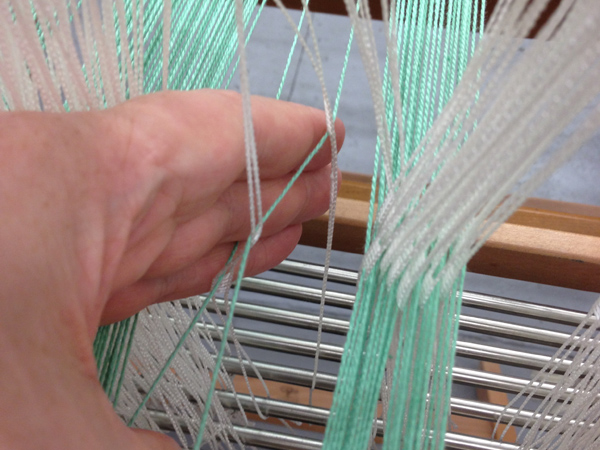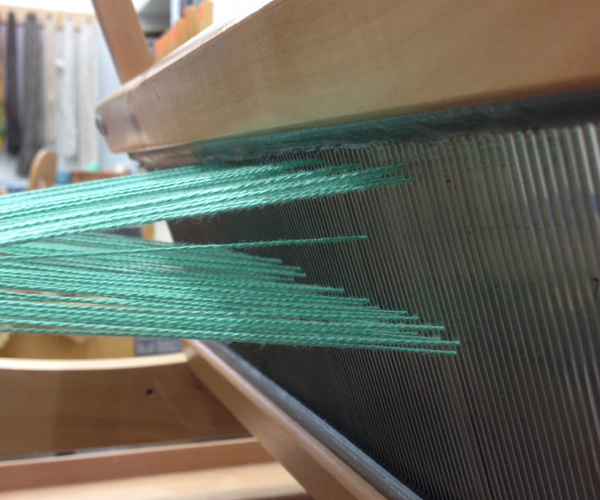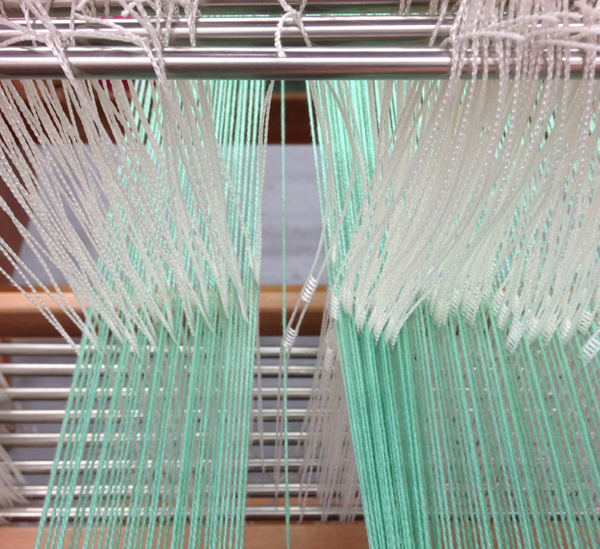We all make mistakes when we are dressing the loom, perhaps especially in the threading. Fortunately, the majority of weaving mistakes are very easily and quickly fixed, but it helps if you seek them out and deal with them systematically. If there is one thing that is worse than finding an error in your threading, it is not finding an error – until you have woven the whole warp!
This guide will help you to find and correct common slip-ups.

Once the warp is tied on and ready to weave, follow these simple steps.
1. Open the plain weave sheds.
The yarn may be sticking together at first, so use your hands to help clear the shed. Open it first one way and then the opposite way. Once you have done this, are there still any ends in the middle of the shed?

If you can see or feel (using your hands or shuttle) that the shed is obstructed, this is most likely to be because
- Two ends have become crossed between the heddle and reed, or
- One end has become wrapped around a neighbouring heddle on its way to the reed
Follow the offending thread back through reed and heddle to identify what went wrong. As you haven’t started weaving yet, it will be easy to fix. Simply untie the appropriate warp bundle from the front apron rod, adjust the ends as necessary and retie.
2. Weave a few picks of plain weave.
Once you have a clean shed, use a contrasting yarn to weave the first three plain weave picks without beating. Then close the shed and beat firmly. Repeat with three more plain weave picks, then beat again on a closed shed. That should be sufficient to spread the warp out and enable you to see the weave structure. (If you are weaving a structure which doesn’t permit true plain weave, such as Ms and Os, then weave whatever is closest to it.)
Are there any warp or weft floats where they shouldn’t be? This is most likely to be a mis-threading. Follow the end (or ends) back to the heddles. You may have threaded the right heddles in the wrong order, e.g. 1-2-4-3 where you meant to thread 1-2-3-4, or you may have picked out an incorrect heddle, e.g. 1-2-4-4 instead of 1-2-3-4.

At this early stage it is still simplest to untie the warp and pull the wrongly threaded ends out of the little piece of plain weave you have done. You can then rethread them correctly. If you have picked out a heddle from the wrong shaft altogether, then you will need to make a repair heddle on the correct shaft to hold the warp end.
Resley and tie on again, with the corrected ends sitting on top of the plain weave. Weave a few more picks to catch these ends and make sure they are in the right place.

3. Weave a few picks in your intended structure.
Use the weave structure you have threaded for, but keep it simple. For example, if you have threaded a twill, then a basic 2/2 twill progression will be a good test.
Are there any irregularities in the pattern? You may need to move away a little to get a clear view.
If you can see something that is a little ‘off’ – for instance a pattern shape that doesn’t look quite as expected – then it may be a threading error. Follow the ends back to the heddles to double check as in step 2.
If at this stage you see a major error – a pattern repeat that isn’t what you had planned, for example – then don’t panic. Take a step back and consider your options before you pull half the warp out! You may be able to make a few small changes which will give you something closer to what you wanted. However, if you do decide to make a major correction, you can at least congratulate yourself that you spotted it early!
If you see an area which appears to be more or less dense than the rest of the weave, you should take a closer look at your sleying. Have you slipped an end into the wrong dent? Sleying errors very often disappear in the wet finishing, so you may not need to change anything. One way to double check is to weave a small sample before you proceed to your project.
4. Check underneath your warp.
When you have woven half an inch or so – or enough so that every end should be caught more than once – put your hands underneath the web and see whether you can feel any unwoven ends. Sometimes an end can be missing from a pattern altogether without producing an obvious visual error.
If a warp end is floating underneath your web, this is likely to be because
- The end is not threaded through the heddle eye, or
- The end is threaded on a shaft you are not using.

Follow the end back to the heddles and correct as above.
5. Weave!
Now you are ready to weave. Stay alert for errors as you proceed, particularly through the first repeat of your pattern.

Share tips, start a discussion or ask one of our experts or other students a question.
No Responses to “Weaving FAQs: Troubleshooting Your Threading”